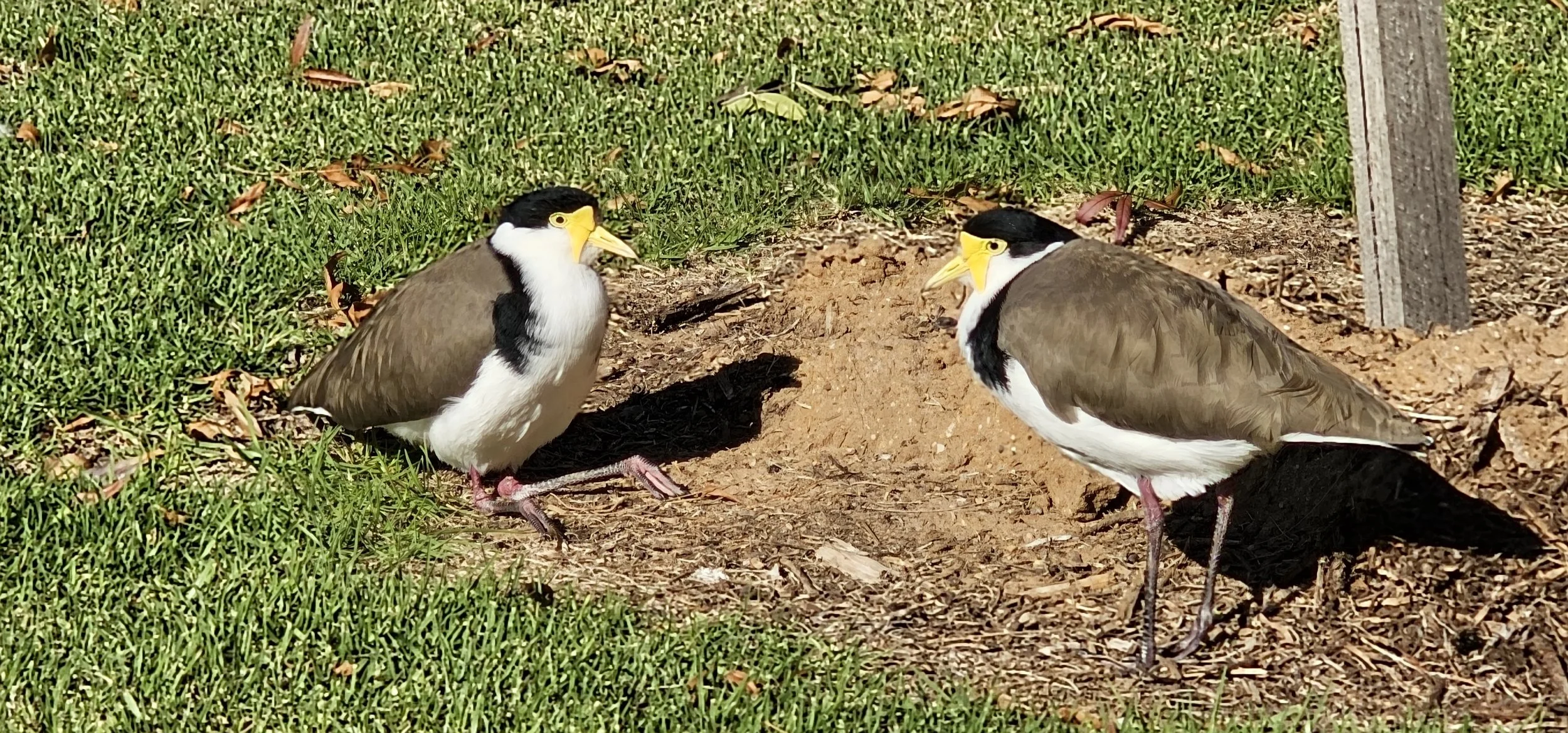by Nicholas Munday, Adelaide Urban Birding
The subject of this article is a bird with a notorious reputation: the assertive, sometimes aggressive, and certainly ever-vigilant Masked Lapwing (Vanellus miles).
Found across the majority of the continent, the Masked Lapwing is a species that has embraced metropolitan areas with great enthusiasm. From sporting ovals to roundabouts, wetlands to grassy verges, Lapwings have seized the opportunities created by human-altered environments and made them very much their own (sometimes to the exclusion of people!).
A member of the Charadriidae or ‘plover’ family, Masked Lapwings belong to a diverse group of ground-dwelling wading birds that are more typically associated with shorelines and open flats.
Yet, unlike their more coastal relatives, Lapwings have adapted superbly to inland environments, usually natural grasslands and open wetlands. The Masked Lapwing, in particular, has taken over your Adelaide Park Lands and are a common sight everywhere that open lawns predominate the landscape.
Masked Lapwings on the banks of the River Torrens / Karrawirra Pari (Park 12). Pic: Shane Sody
Lapwings display a few characteristics that distinguish them from other members of the ‘plover’ family. The trademark features of the Masked Lapwing include exceptionally long legs built for striding across open land, a striking yellow face mask, and prominent yellow wattles that drape from either side of the bill.
The distinctive yellow wattles and facial mask of a Masked Lapwing. Photograph by Adelaide Urban Birding.
Despite the dramatic facial ornamentation, there is little sexual dimorphism between the male and female of the species; both appear near-identical at a distance.
Their plumage is crisp and elegant: white underparts, a black crown and hind neck, and warm-brown wings edged in darker tones. Another diagnostic feature is a distinctive yellow spur on the ‘elbow’ (carpal) joint of the wing, which is particularly prominent on male birds, and gives the bird its other common name: the Spur-Winged Plover.
The Masked Lapwing is sometimes confused with its less common relative, the Banded Lapwing (Vanellus tricolor), although that species is more often found in open farmland or semi-arid regions and have yet to make the jump to urban environments. The Banded Lapwing also lacks the wattles of the Masked Lapwing, and has much more prominent black bands across its face and breast.
In natural environments, Masked Lapwings favour grasslands, floodplains, and open country bordering wetlands, where they forage for insects and other small invertebrates; however, their successful colonisation of urban areas reflects their simple habitat requirements: open ground for feeding and flat surfaces for nesting.
Masked Lapwings on the banks of the River Torrens / Karrawirra Pari (Park 12). Pic: Rod Lewis
Their nesting behaviour is the source of their notorious reputation. Masked Lapwings do not make a conventional nest and lay their eggs in the most unassuming of places, usually bare earth or flat grassy areas (football ovals are a particular favourite). With such exposed ‘nests’, vigilance is essential, and these birds have evolved a formidable defence strategy. A nesting pair will stand their ground fearlessly, issuing piercingly loud alarm calls and performing threat displays. When that fails, the birds will take to the air and swoop aggressively and unrelentingly until the threat goes away. There is no doubt these birds take parenting seriously!
Masked Lapwing on open ground in the Adelaide Botanic Garden. Photograph: Adelaide Urban Birding.
Within the Adelaide region, Masked Lapwings can be encountered almost everywhere that includes flat, open grass, making the Adelaide Park Lands prime real estate for these assertive residents. Their preference for mown lawns and shallow wetlands means that they thrive in areas where many other native species do poorly.
Lapwings are a near-permanent fixture of Victoria Park / Pakapakanthi (Park 16) and the surrounding playing fields, and can also be found regularly around the wetlands of Bonython Park / Tulya Wardli (Park 27). Botanic Park (Park 11) and Rymill Park / Murlawirrapurka (Park 14) are also strongholds.
There is an iNaturalist page, which can show you exactly where citizen scientists (like you!) have observed Masked Lapwings in Adelaide and elsewhere.
To find out about other birds in your Adelaide Park Lands, check out our What Bird is That? series.
Top (banner) photo: The threatening stare of the Masked Lapwing, taken in the Adelaide Botanic Garden (Park 11). Photograph: Adelaide Urban Birding.
Nicholas Munday is an environment and planning lawyer with degrees in law and science (evolutionary biology and ecology) from the University of Adelaide.
He has a strong interest in biodiversity conservation and runs the ‘Adelaide Urban Birding’ Instagram account (@adelaideurbanbirding), dedicated to his photography of native birds in the Adelaide metropolitan area.
In his free time, Nicholas is well-known in the Adelaide choral music and theatre communities and also enjoys bushwalking, writing, and, of course, photography.
The opinions expressed in this article are entirely those of the author. This author is not affiliated with the Adelaide Park Lands Association Inc.








